一、Java中的文件
1、路径的表示方式
因为Java中\被用作转义字符,
-
Windows系统的路径最好用
\\来分隔,如:c:\\temp\\test.txt(也可使用/分隔) -
Linux下此路径就应该这样写:
c:/temp/test.txt
如果要考虑跨平台,则最好这样写:"c:" + File.separator+" temp" + File.separator + " 文件名"
2、File类的构造函数
| 构造方法 | 简介 |
|---|---|
| File(File parent,String child) | 建立一个以parent加上child为路径的File组件 |
| File(String pathname) | 建立一个以pathname为路径的File组件 |
| File(String parent,String child) | 建立一个以parent加上child为路径的File组件 |
3、常用方法
| 方法 | 说明 |
|---|---|
| File.exists() | 文件或者目录是否存在 |
| File.isFile() | 是否是文件 |
| File.isDirectory() | 是否是目录 |
| File.getName() | 取文件或者目录的名字 |
| File.getPath() | 取文件或者目录的路径 |
| File.getAbsolutePath() | 取文件绝对路径 |
| File.lastModified() | 最后修改日期 |
| File.length() | 文件或者目录的子节大小 |
| File.createNewFile() | 创建新文件 |
4、示例
4.1、创建文件
package com.it.file;
import java.io.File;
import java.io.IOException;
public class FileTest {
/**
* @param args
*/
public static void main(String[] args) {
File fi=new File("e:/test/helo");
File file=new File(fi,"aa.txt");
if(!fi.exists()){
fi.mkdirs();
}
try {
file.createNewFile();
} catch (IOException e) {
// TODO Auto-generated catch block
e.printStackTrace();
}
}
4.2、文件的操作
获取当前目录下所有文件和文件的大小
import java.io.*;
public class FileSize{
public static void main(String[] args) {
File files=new File(".");
String[] list=files.list();
for(int i=0;i<list.length;i++){
File file=new File(list[i]);
System.out.println(list[i]+file.length());
}
}
}
.代表当前目录
二、流
1、流的概念
流是指程序用运行中的数据通信信道,流类所关心的是文件的内容。流使我们将实际I/O设备中处理数据的细节动作隐藏起来。
什么是数据流?
-
表示了字符或者字节数据的流动序列
-
数据源和程序之间的数据传输
-
数据流是指所有的数据通信通道
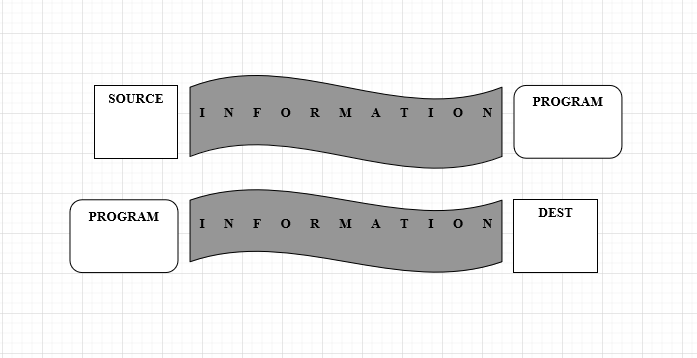
2、输入输出
我们通常提到的输入输出,都是立足于编程者角度上的,
2.1、什么是输入输出
-
所谓输入:就是将编程者所设计的程序看作流的终点
-
所谓输出:是将程序看作流的起点
在java中输入、输出功能是通过有关流的操作来完成的,需要使用java.io包中的类
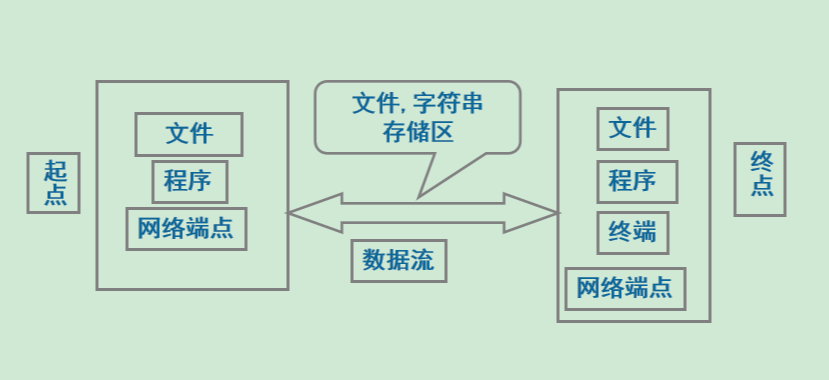
2.1、基本的输入输出对象
System类提供了标准输入输出流和错误流
| 用法 | 类型 | 说明 |
|---|---|---|
| System.out | PrintStream | 把输出送到缺省的显示(通常是显示器) |
| System.in | InputStream | 从标准输入获取输入(通常是键盘) |
| System.err | PrintStream | 把错误信息送到缺省的显示 |
每当main方法被执行时,就自动生成上述三个对象
3、流的分类
3.1、从读写操作角度划分:
-
输入流:就是把程序看作终点,通过
read方法把内容读到流管道的过程 -
输出流:就是把程序看作起点,通过
write方法把内容写到流管道的过程
3.2、从传输内容角度划分:
-
字节流:会以字节的形式来处理数据。
-
字符流:会以字符的形式来处理数据
三、字节流
字节流采用ASCII编码即一个字节(8个位)为单位进行数据的输入和输出。
如果是音频文件、图片、歌曲、等内容用字节流
1、字节流分类
所有的输入和输出在较低层次上都是面向字节的
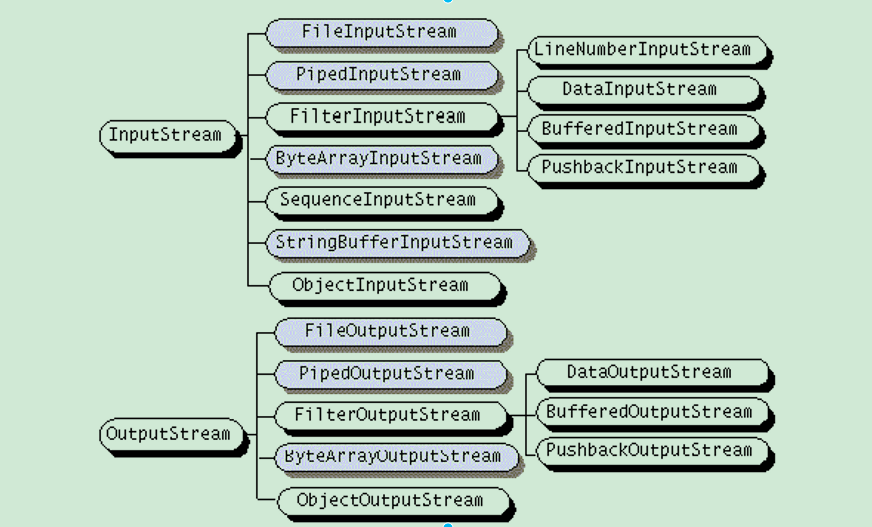
1.1、InputStream类
InputStream类是所有输入流类的基类,InputStream类的方法有:
-
read():从流中读入数据
-
skip():跳过流中若干字节数
-
available():返回流中可用字节数
-
mark():在流中标记一个位置
-
reset():返回标记过得位置
-
markSupport():是否支持标记和复位操作
-
close():关闭流
1.2、OutputStream
OutputStream类是所有输出流类的基类,也是个抽象类,常用方法有:
-
Close():关闭输出流
-
flush():清空输出流缓冲区
-
write(int b):写入单个字节到输出流
-
write(byte[] buffer):写入一个字节数组到输出流。
2、FileInputStream
FileInputStream的常用方法:
| 方法 | 说明 |
|---|---|
| void close() | 关闭此文件输入流并释放与此流有关的所有系统资源 |
| int read() | 从输入流中读取一个数据字节 |
| int read(byte[ ] b) | 从输入流中将最多b.length个字节的数据读入到一个字节数组中 |
示例
public static void main(String[] args) {
File file = new File("test.txt");
byte[] bt = new byte[(byte) file.length()];
try {
FileInputStream fis = new FileInputStream(file);
fis.read(bt);
for (int i = 0; i < bt.length; i++) {
System.out.print((char) bt[i] + "\t");
}
} catch (FileNotFoundException e) {
e.printStackTrace();
} catch (IOException e) {
e.printStackTrace();
}
}
3、FileOutputStream
FileOutputStream的常用方法:
| 方法 | 说明 |
|---|---|
| void close() | 关闭文件输出流并释放与此流有关的所有系统资源 |
| void write(byte[ ] b) | 将b.length个字节从指定字节数组写入到此文件输出流中 |
| void write(int b) | 将指定字节写入到此文件输出流 |
示例
public static void main(String[] args) {
try {
FileOutputStream fos = new FileOutputStream(new File("test.txt"));
for (int i = 97; i < 123; i++) {
fos.write((char) i);
}
fos.flush();
System.out.println("写入成功!");
} catch (FileNotFoundException e) {
e.printStackTrace();
} catch (IOException e) {
e.printStackTrace();
}
}
4、文件拷贝

文件拷贝即要用到输入流,又要使用到输出流操作:
FileInputStream in=new FileInputStream(fp); FileOutputStream out=new FileOutputStream(fp);
输入流的参数是用于输入的文件名
输出流的参数是用于输出的文件名
public class FileStreamDemo {
public static void main(String[] args) {
try {
File inFile = new File("file1.txt");
File outFile = new File("file2.txt");
FileInputStream fis = new FileInputStream(inFile);
FileOutputStream fos = new FileOutputStream(outFile);
int c;
while ((c = fis.read()) != -1)
fos.write(c);
fis.close();
fos.close();
} catch (IOException e) {
System.out.println("文件不存在");
}
}
}
5、缓冲的输入输出
5.1、缓冲区流的简介
Java在提供了字节流的缓冲区流:
-
BufferedInputStream
-
BufferedOutputStream
通过缓冲区流,减少访问硬盘的次数,提高效率

5.2、缓冲区流的特点
-
只有缓冲区满时,才会将数据送到输出流.
-
Java在输出数据流中,当对方尚未将数据取走时,程序就会被阻塞.
-
有时要人为地将尚未填满的缓冲区中的数据送出,使用
flush()方法.
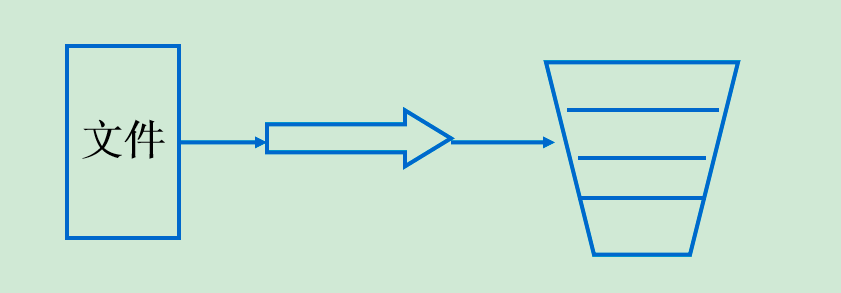
5.3、示例
public class BuffStreamDemo {
public static void main(String[] args) {
try {
FileInputStream in = new FileInputStream("file1.txt");
BufferedInputStream bin = new BufferedInputStream(in, 256);
byte bArray[] = new byte[256];
int len = bin.read(bArray);
System.out.println(len);
in.close();
bin.close();
} catch (IOException e) {
}
}
}
四、字符流
字符流采用UNICODE编码即2个字节(16个位)为单位进行数据的输入和输出。
如果是关系到中文(文本)的内容读写操作,用字符流比较好
1、字符流分类
由于字符流采用的是UNICODE编码,因此能够进行国际化,这时字符流比字节流更有效,所以它对多国语言支持性比较好。
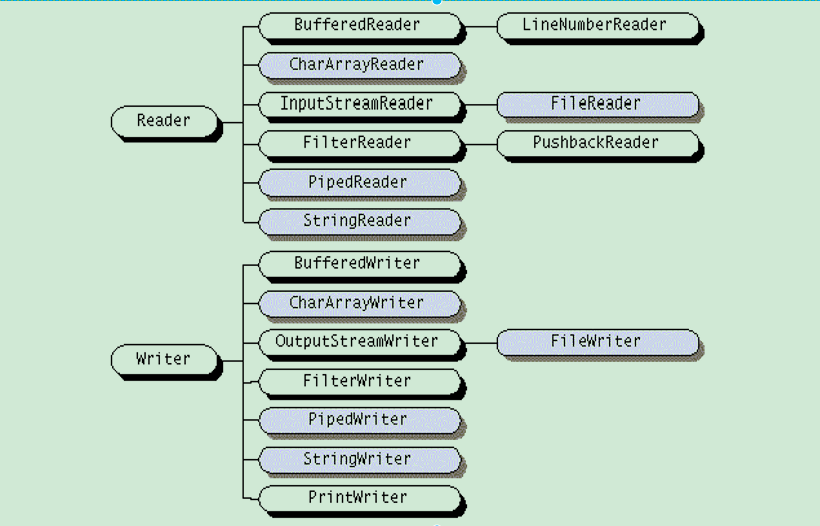
1.1、Reader
Reader类是所有输入流类的基类,是个抽象类。Reader类对应的子类的所有方法在发生错误时都会抛出IOException异常
Reader的常用方法:
| 方法 | 说明 |
|---|---|
| abstract void close() | 关闭输入源 |
| int read() | 从输入流读取单个字符的整数表示,如果不存在则返回-1 |
| int read(char buffer[ ]) | 从输入流中将字符读入数组,如果遇到文件结尾,返回-1 |
| long skip(long n) | 跳过n个字符,返回跳过的字符数 |
1.2、Writer
Writer类是所有输出流类的基类,也是个抽象类。
Writer的常用方法:
| 方法 | 说明 |
|---|---|
| abstract void close() | 关闭输出流 |
| Writer append(char c) | 将指定字符追加到此 writer |
| void write(int ch) | 写入单个字符到调用的输出流 |
| void write(String str) | 写入str到调用输出流 |
| abstract void close() | 关闭输出流 |
| abstract void flush() | 清空输出缓冲区 |
2、InputStreamReader
InputStreamReader继承了Reader,它实现了Reader的抽象方法。
-
InputStreamReader是字节流通向字符流的桥梁,它使用指定的charset读取字节并将其解码为字符。
-
每次调用InputStreamReader中的一个read()方法都会导致从基础输入流读取一个或多个字节。
-
为了达到最高效率,可以考虑在BufferedReader内包装InputStreamReader,BufferedReader类在后面小节中介绍
//例如以下语句把一个读取从控制台输入的InputStreamReader转换为了BufferedReader BufferedReader in = new BufferedReader(new InputStreamReader(System.in));
2.1、InputStreamReader的常用方法
| 方法 | 说明 |
|---|---|
| void close() | 关闭该流并释放与之关联的所有资源 |
| String getEncoding() | 返回此流使用的字符编码的名称 |
| int read() | 读取单个字符 |
| boolean ready() | 判断此流是否已经准备好用于读取 |
2.2、示例
public static void main(String[] args) {
File file = new File("test.txt");
InputStream is = null;
try {
is = new FileInputStream(file);
} catch (FileNotFoundException e) {
e.printStackTrace();
}
InputStreamReader reader = new InputStreamReader(is);
try {
int i = 0;
while ((i = reader.read()) > 0) {
System.out.print((char) i + "\t");
}
} catch (IOException e) {
e.printStackTrace();
}
}
3、OutputStreamWriter
OutputStreamWriter继承了Writer,它实现了Writer的抽象方法。
-
OutputStreamWriter是字符流通向字节流的桥梁,这刚好与InputStreamReader相反。
-
他使用指定的charset将写入的字符编码转换为字节输出。
-
它使用的字符集可以由名称指定或显示给定,否则可能接受平台默认的字符集。
注意,传递到此write()方法的字符是未经缓冲的。为了达到最高效率,可考虑将OutputStreamWriter包装到BufferedWriter中以避免频繁调用转换器,BufferedWriter类将在后面小节中介绍
//例如以下语句把一个读取从控制台输入的InputStreamReader转换为了BufferedReader BufferedWriter out= new BufferedWriter(new OutputStreamWriter(System.out));
3.1、OutputStreamWriter的常用方法
| 方法 | 说明 |
|---|---|
| void close() | 关闭该流并释放与之关联的所有资源 |
| String getEncoding() | 返回此流使用的字符编码的名称 |
| void write(char[] cbuf, int off, int len) | 写入字符数组的某一部分 |
| void flush() | 刷新该流的缓冲 |
3.2、示例
public static void main(String[] args) {
String str = "大家好";
try {
OutputStreamWriter osw = new OutputStreamWriter(new FileOutputStream(new File("test.txt")));
osw.write(str, 0, str.length());
osw.flush();
osw.close();
System.out.println("文件写入成功。");
} catch (FileNotFoundException e) {
e.printStackTrace();
} catch (IOException e) {
e.printStackTrace();
}
}
4、FileReader
此类继承了InputStreamReader,所以除了有InputStreamReader的功能以外还有自己的一些功能,可以使用它直接读取文件的内容。它也是读取字符文件的便捷类
4.1、FileReader的常用方法
| 方法 | 说明 |
|---|---|
| int read() | 读取单个字符,返回值为数据内容 |
4.2、示例
public static void main(String[] args) {
FileReader reader = new FileReader("test.txt");
try {
int i = 0;
while ((i = reader.read()) > 0) {
System.out.print((char) i + "\t");
}
} catch (IOException e) {
e.printStackTrace();
}
}
5、FileWriter
此类继承了OutputStreamWriter类,所以它有OutputStreamWriter类的全部功能。另外它还有自己的一些功能,可以使用它创建一个写文件的对象,它也是向文件写入字符的便捷类
5.1、FileWriter的常用方法
| 方法 | 说明 |
|---|---|
| void write(char[ ] cbuf, int off, int len) | 写入字符数组的某一部分 |
| void write(int c) | 写入单个字符 |
| void write(String str, int off, int len) | 写入字符串的某一部分 |
5.2、示例
public static void main(String[] args) {
char c[]={'人','之','初','性','本','善','性','相','近','习','相','远'};
try{
FileWriter fw=new FileWriter("三字经a.txt");
fw.write(c);
fw.flush();//刷新
}catch(IOException e){
e.printStackTrace();
}
}
6、BufferedReader
BufferedReader由Reader类扩展而来,提供通用的缓冲方式文本读取,而且提供了很实用的readLine()方法
//例如以下语句把一个读取从控制台输入的InputStreamReader转换为了BufferedReader BufferedWriter out= new BufferedWriter(new OutputStreamWriter(System.out));
6.1、BufferedReader有两个构造函数
| 方法 | 说明 |
|---|---|
| BufferedReader(Reader inputStream) | 创建使用缺省尺寸输入缓冲区的缓冲字符输入流 |
| BufferedReader(Reader inputStream,int bufsize) | 创建一个使用指定大小输入缓冲区的缓冲字符输入流 |
6.2、BufferedReader的常用方法
| 方法 | 说明 |
|---|---|
| void close() | 关闭该流并释放与之关联的所有资源 |
| int read() | 读取单个字符 |
| int read(char[] cbuf, int off, int len) | 将字符读入数组的某一部分 |
| String readLine() | 读取一个文本行 |
| boolean ready() | 判断此流是否已准备好被读取 |
| long skip(long n) | 跳过n个字符,并返回跳过的字符数 |
6.3、示例
public class CharInput {
public static void main(String args[]) throws IOException {
String s;
InputStreamReader ir;
BufferedReader in;
ir = new InputStreamReader(System.in);
in = new BufferedReader(ir);
s = in.readLine();
int i = Integer.parseInt(s);
i = i * 2;
System.out.println("the result is" + i);
}
}
7、PrintWriter
PrintWriter继承了Writer类,但除此之外此类还实现了PrintStream中的所有print()方法, PrintWriter可以直接输出字符串
7.1、PrintWriter的常用方法
| 方法 | 说明 |
|---|---|
| void print(Object obj) | 打印对象 |
| void write(String s) | 写入字符串 |
| void close() | 关闭该流并释放与之关联的所有系统资源 |
| void flush() | 刷新该流的缓冲 |
7.2、示例
public static void main(String args[]) throws IOException {
String s="人之初 性本善 性相近 习相远";
try{
FileWriter fw=new FileWriter("三字经a.txt");
PrintWriter pw=new PrintWriter(fw,true);
pw.println(s);
}catch(IOException e){
e.printStackTrace();
}
}





















 1234
1234











 被折叠的 条评论
为什么被折叠?
被折叠的 条评论
为什么被折叠?








